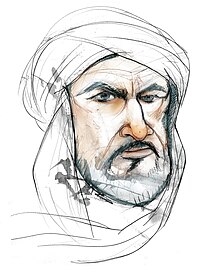
Back إبراهيم بن يحيى الزرقالي Arabic ابراهيم بن يحيى الزرقالى ARZ Az-Zarqalí Catalan زەرقەلی CKB Az-Zarkálí Czech Az-Zarqali German Azarquiel Spanish Az-Zarqali Basque ابراهیم زرقالی Persian Al-Zarqali French
Abū Ishaq Ibrahim al-Zarqali | |
|---|---|
 An artist's impression | |
| Personal | |
| Born | 1029 CE |
| Died | 1100 |
| Religion | Islam |
| Era | Islamic Golden Age |
| Region | Al-Andalus, Taifa of Toledo |
| Notable work(s) | Tables of Toledo |
Abū Isḥāq Ibrāhīm ibn Yaḥyā al-Naqqāsh al-Zarqālī al-Tujibi[2] (Arabic: إبراهيم بن يحيى الزرقالي); also known as Al-Zarkali or Ibn Zarqala (1029–1100), was an Arab maker of astronomical instruments and an astrologer from the western part of the Islamic world.[2]
Although his name is conventionally given as al-Zarqālī, it is probable that the correct form was al-Zarqālluh.[3] In Latin he was referred to as Arzachel or Arsechieles, a modified form of Arzachel, meaning 'the engraver'.[4] He lived in Toledo, Al-Andalus before moving to Córdoba later in his life. His works inspired a generation of Islamic astronomers in Al-Andalus, and later, after being translated, were very influential in Europe. His invention of the Saphaea (a perfected astrolabe) proved very popular and was widely used by navigators until the 16th century.[5]
The crater Arzachel on the Moon is named after him.[4]
- ^ Abū Isḥāq Ibrāhīm ibn Yaḥyā al-Naqqāsh al-Zarqālī, "Biographical Encyclopedia of Astronomers", ed.Virginia Trimble, Thomas R. Williams, Katherine Bracher, Richard Jarrell, Jordan D. Marché, F. Jamil Ragep, (Springer, 2014), 1258.
- ^ a b Julio, Samsó (March 2018). "Ibn al-Zarqālluh".
- ^ s.v. "al-Zarqālī", Julio Samsó, Encyclopaedia of Islam, New edition, vol. 11, 2002.
- ^ a b Weever, J. (1996). Chaucer Name Dictionary: A Guide to Astrological, Biblical, Historical, Literary, and Mythological Names in the Works of Geoffrey Chaucer. Routledge, 1996. p. 41. ISBN 9780815323020.
- ^ "Spain - Culture of Muslim Spain". Encyclopedia Britannica.: A number of these scholars sought to simplify the astrolabe, and finally al-Zarqālī (Azarquiel; died 1100) achieved success by inventing the apparatus called the azafea (Arabic: al-ṣafīḥah), which was widely used by navigators until the 16th century.
© MMXXIII Rich X Search. We shall prevail. All rights reserved. Rich X Search